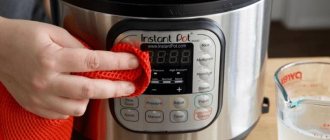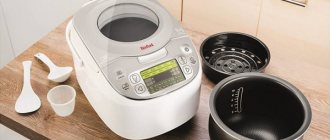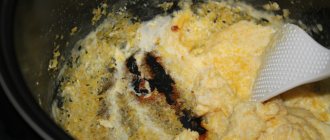It’s great when the cooking process is mechanized, then creating culinary masterpieces brings pure pleasure. Alas, not every manufacturer includes detailed maintenance instructions. Experts in the field of repairing household appliances will offer several ways to disassemble a multicooker of different models. With these tips you can save a lot of money on your family budget.
Kitchen assistant from
In most cases, disassembling a multicooker will not be difficult, because they are assembled according to approximately the same scheme. For a home craftsman who has at least once encountered the repair of electrical appliances where the basis is a heating element, the principle of the device will be clear. Below are the main external parts of the case:
- A sealed lid with a rubber band, on top of which there is a removable steam valve.
- Bowl for cooking (in older models it is built into the body, which is not particularly convenient).
- Metallized case, with plastic elements (the appearance and finishing materials completely depend on the cost of the device: in flagship models there are all-iron models).
- A button that opens the lid.
- Base (bottom).
- Inside, under the bowl, there is a heating element disk (heater).
- Software buttons, control panel screen (sometimes absent, in budget lines).
- Handle for easy carrying. It can be located on top or on the body.
Design and equipment of the Polaris multicooker, middle class
What's inside the miracle - the pot?
The picture shows which wires are on the bottom of the multicooker.
Power is supplied through red wires. The switch (which puts the device into operation) and the thermal fuse (protects against overheating) are installed in series. The voltage from the thermal fuse is supplied to one terminal of the heating element, to the power supply board. The white wire is connected to the power directly. Through it, voltage is supplied to the second terminal of the heating element and closes the relay contacts. Wires that supply voltage and ensure operation
Under the heating element there is a power supply with standard wiring. It is the most loaded part of the multicooker. Its task is to convert the current of 220V to direct current 5V and 12V (the first supplies power to the control unit, and the second – the switching circuit, activates the relay). The home network supplies power to the three-pin connector, which is located at the bottom. A yellow-green wire stands out: this is grounding.
Schematic representation of the internal structure of the Redmond RMC-M23 multicooker
Often, manufacturers install a universal board for the entire model line into the device. Naturally, technological nuances are kept secret, because companies do not count on the introduction of self-taught craftsmen into household appliances. When looking at the photo, an insulated metal round disk catches the eye. This is a battery that, when disconnected from the network, stores preset cooking programs in memory.
In the picture the battery is shown at the bottom (yellow)
What to look for when choosing?
Which one to choose? When choosing a multicooker, experts recommend paying attention to the following points:
- power. Models with high power are able to cook the desired dish in half the time. Therefore, in order to save time, it is worth considering devices with a power of 700 W or more;
- bowl volume. The best option is considered to be a device with a 5 liter bowl, which is quite enough for a family of 4 people. If the family is large, it is better to purchase a model with a larger bowl;
- number of programs. A device with a large number of programs will cost more, however, the cooking process will be significantly simplified.
Typical errors and their characteristics
Each multicooker model has a user manual, which shows possible causes of errors and the inability to continue operation.
In some cases, the same code may indicate several malfunctions at once, so this factor must be taken into account.
Before you take your multicooker in for repair, you can try to find out what exactly is the reason. The following tip will help with this.
| Error code | Possible reasons |
| E1 | Moisture gets on the heating element or it burns out |
| E2 | Broken power cable or faulty top heat sensor |
| E3 | Possible moisture on the heating shade or the lid is not tightly closed |
| E4 | Board fault or clogged pressure sensor |
| E5 | Automatic shutdown of the multicooker due to overheating. Prevents premature wear of the ten. |
Expert opinion Pavel Maksimovich Torsunov
In some cases, errors cannot be resolved on your own or their code is displayed incorrectly. Then you cannot do without qualified repair specialists. Initially, you need to understand what could trigger the appearance of a particular code on the display and try to eliminate this reason as far as possible.
E1
This error occurs in three cases:
- There is a hole in the bowl through which the liquid enters the heating element.
- Foreign objects and food residues get on the heating element, which causes combustion processes.
- Malfunction of the ten itself and its burnout.
To make sure the heater is working properly, it is recommended to unplug the multicooker, carefully open the lid and remove the bowl. Next, plug the plug into the outlet and control the heating process. Its absence provides the answer to why the E1 code appeared.
E2
This problem most often occurs due to a break in certain parts of the cable, the connection of which to the multicooker does not cause it to turn on. You can check this reason by connecting an alternative cable (you can ask your friends or neighbors). If the device works when it is connected, then the reason has been found.
Sometimes E2 appears when the thermal sensor located at the top is shorted. It is recommended to open the lid, carefully remove the bowl and observe the operation of the heating element when the plug is plugged in. If the error appears again when closing the lid, then the malfunction has been found.
E3
The most common mistake that occurs is when the lid is not tightly closed. In some models it is accompanied by a characteristic sound signal.
It also appears when liquid gets on the heating element. It is necessary to carefully remove the bowl and look at its condition from below. Perhaps crumbs, small particles of vegetables, cereals have stuck to it.
E4
The most difficult error, as it indicates a malfunction in the central board, which regulates all processes of the multicooker. The second reason is a malfunction of the pressure sensor. Only a specialist can find the problem and fix it.
E5
If the machine is used throughout the day and the heating element experiences increased loads, the automation is triggered, which provokes a forced shutdown. This is necessary to prevent the heating element from burning out prematurely.
Repairing minor damage to covers and buttons at home. Errors
In budget-class multicookers Delphi, Polaris, Rotex, Scarlet, Redmond, the button that closes the lid often breaks. Masters attribute this feature to birth defects. It happens that the button does not work due to improper use, but due to exposure to high temperatures. If the device is under warranty, it is better to contact the service. To deal with this problem, you will have to disassemble the case and break the seals.
When closing the lid, the hostess needs to first hold down the button, and after closing it completely, release it. Less load on the part reduces the chance of failure.
Broken open button
Two repair options that do not require complete disassembly:
- The surface is degreased, glue is applied and magnets are placed so that after closing the lid they meet. You can take one large one, but it’s better to take four small ones to connect them in pairs.
- In the fallen button, two small holes are made for the rod. The same is done in the body, at the place where the latch is attached. Then, thread the rod through the removable part. Carefully insert the structure into the body.
Parts are purchased at the store; the use of homemade inventions is not advisable. Using these may cause a fire! Moreover, the price is not high for elements that can be replaced at home. If adequate operation of the device is disrupted, system errors appear on the screen. By reading them, it will become approximately clear which part needs repair and replacement.
E1, E2 - there have been changes in the operation of the power supply, heating element, the lid is not tightly closed.
E3, E4, E5 - the device overheated and the protective function worked, the temperature sensor broke. In some models, when this malfunction occurs, no picture is displayed on the screen. If we are talking about, then a possible ailment could be a damaged wire that runs through the body and cover. We disassemble, remove the plastic at this interval (snaps off with a screwdriver) and measure the resistance. The next step is to disassemble the bottom and ring the terminals under the heating element.
All devices are equipped with fuses that blow in any situation that, in the opinion of the developers, could lead to danger. For example, if the housewife turns on the device, but forgets to install the bowl inside.
When purchasing a multicooker, be sure to familiarize yourself with its characteristics: the presence of a removable lid, whether the rubber bands can be replaced at home, how reliable the latch is. To extend the service life of the appliance, maintain hygiene inside and outside, avoid getting grains and leftover food, use it for its intended purpose and follow the instructions.
Cover with elastic fastening
To carefully disassemble parts, it is important to know the operating principle of the multicooker. It seems that this seemingly ordinary pan does not have a complex pattern, but it does not. There is a fragile electrical part inside. It can be easily damaged if the body is handled roughly.
Source
Design and principle of operation
All blenders are divided into several categories, which differ from each other in design and method of use, as well as different attachments and functionality. To effectively and correctly carry out repairs, you should understand the design features.
Stationary
Stationary varieties look like small food processors and are bowls with knives rotating inside. As a rule, the knives are installed at the bottom of the bowl. The device is desktop and does not need to be held during operation. This blender model is capable of grinding a large portion of food at a time.
The main disadvantage of stationary devices is the need to allocate a lot of storage space. In addition, some models do not chop vegetables well and grind them into crumbs or leave too large pieces. In terms of repairs, stationary equipment is much easier to disassemble and repair compared to submersible equipment.
Manual (submersible)
Hand blenders are shaped like a long handle with a cutting end. The nozzle is lowered into the container with the products, the device is turned on and held until the grinding process is completed. Due to their compact size, submersible devices do not require much storage space in the kitchen. The ability to change attachments significantly expands the list of food preparations.
This creates discomfort during long-term cooking. Also, the device is not suitable for stirring large portions of food.
Choosing detergents
During the cooking process, various food particles often get into the interior of an electrical appliance.
Some housewives, in a hurry to prepare lunch or dinner, violate the rules for the sequence of placing food in a multicooker: they place food in the bowl without first removing it. To clean the unit, it is unacceptable to use hard sponges and abrasive detergents, as they can easily damage the internal and external parts of the device.
The best option for removing contaminants from the surfaces of the device are mild chemicals and home remedies.
Household
- Care kit for Zumman multicookers - the German product kit includes a liquid cleaning agent, wet wipes with varying degrees of lint hardness on the front and back sides. With the help of napkins, you can quickly and effectively remove dirt from any surfaces of the device; in case of significant accumulation of plaque on the elements of the unit, use the product in the form of a liquid.
- Top House is a gel designed for the care of household appliances used for cooking and non-stick cookware. To remove grease stains from a multicooker, apply a small amount of gel to a sponge, foam it and treat the contaminated surfaces, then remove the remaining product with a damp cloth and rinse the device.
- Sanita spray “1 minute” is a domestic product that can effectively remove stubborn grease deposits and is suitable for cleaning various types of surfaces. After spraying the drug onto contaminated areas, wait 1-2 minutes and wipe the treated areas with a damp cloth, then rinse with water.
Folk
In some cases, the use of household chemicals is not suitable for caring for an electrical appliance: for example, a person experiences an allergic reaction upon contact with a certain product.
After using ready-made preparations for cleaning surfaces that will then come into contact with food, the treated containers must be washed several times in clean water. If the rinsing procedure is not carried out thoroughly, the remaining chemical particles can have a negative effect on the living organism.
Citric acid perfectly cleans the microwave from grease.
It should be said that most available products have no less cleaning effect than special preparations:
- pour 25 g of citric acid into 200 ml of warm water, stir the ingredients;
- pour the solution into the bowl of the electrical device and turn on the steam cooking mode for 15 minutes, then drain the liquid, rinse the tank and wipe it dry.
Lemon will help get rid of plaque and eliminate unpleasant odors: pour a glass of water into the bowl and place half a citrus fruit there. As with citric acid, turn on the device in steam mode for a quarter of an hour. After the time has passed, drain the liquid and wash the tank in running water and dry it.
Find out how to descale an electric kettle using citric acid. This article will tell you about cleaning your iron from limescale.
Loading …
How to completely disassemble a multicooker? Full scheme of actions
There are temperature sensors in the lid and bottom of the product - therefore, you need to disassemble the multicooker with extreme caution so as not to disturb these delicate wiring. One wire is connected to the touch screen
A lot depends on these parts - they are the “brain” of the device. Due to damage to the temperature sensors, programs and cooking modes may fail. Moreover, the kitchen assistant may not turn on because the required set of heat indicators does not occur.
Preparation
- The device is disconnected from the network, wait until it cools down completely.
- Wipe the lid from grease with a soft cloth.
- If the grease cannot be scrubbed off, use mild dishwashing detergents without abrasives.
- Wipe the lid dry.
Removable element on a screw
Operating procedure
- The cover of the electrical appliance is opened.
- In the area of the lid there are two plastic latches. You need to press on them and push towards the center.
- The upper sector is pulled towards itself, and then sharply down.
- All internal parts are thoroughly washed to remove food debris.
- To put the part in place, perform the reverse steps. If everything is installed correctly, the clips will click when seated correctly.
If the product is broken and you need to see the internal parts, but the master does not know how to carefully disassemble the multicooker, then:
- First of all, wipe all contaminated areas of the product with a rag.
- The electrical appliance is turned upside down.
- The bottom cover is held in place by a screw, unscrew it. Dismantle the bottom.
Removing the lower part
- All removable wires going to the board are disconnected.
- Unscrew the screws holding the heating element.
- Remove the thermocouple and all microcircuits.
- Unscrew the screw holding the top cover (when the model does not provide for removal). Then, press the cover with a screwdriver and remove the temperature sensors.
- Remove the plastic rings on the latches (if there are any at the edges of the metal case).
- The inner walls are taken out from the outer ones.
How to care for the removable inner aluminum cover?
To carry out proper cleaning, you need to know how to remove the lid of the Redmond multicooker. It is recommended to do this according to the following scheme:
- Open the lid of the device; it opens easily.
- Press the two plastic tabs towards the center of the lid until they are completely open.
- Gently pull it towards you, then down, until it detaches from the main cover.
- Then wash it thoroughly and wipe with a damp cloth.
- Connect all parts in reverse order. Insert the cover into the upper grooves to align it with the base. Press the latches until you hear a click so that it fits tightly.
Now you know how to disassemble and reassemble the lid of the Redmond multicooker after careful treatment with detergents.
Important! Has your miracle pot stopped turning on? In our separate review, you will learn about the main causes of malfunctions of Redmond multicookers and their solutions.
Where to find and how to replace the thermal fuse
Several thermal fuses are always located in the middle of the multicooker, no matter what brand it is. They are located behind the cambrics that cover the plume. In every multicooker, the cambrics are located in plain sight. In some models they can be assembled into a clamp, but more often they are not fixed in any way.
If you are repairing a Philips multicooker, you can unscrew the bottom of the device with your own hands and find the fuses.
Under the saucepan there is a knot that looks like a massive metal mushroom, supported from below by a spring. If you disassemble the multicooker, you will find fuses around this mushroom.
Thermal fuses should only be attached using clamps. For obvious reasons, you cannot solder them.
What you can fix yourself
If the device malfunctions, you can take some actions yourself:
- Cleaning the device. It is carried out in accordance with the above algorithm of actions (disassembling the device and cleaning its parts).
- Replacing thermal fuses. There are two of them, the fuses are covered with cambrics. The first one is located in the middle of the multicooker, in the middle clamp, or is fixed separately. You cannot solder the thermal fuse, because the part is very sensitive to high temperatures. It can only be replaced with a new one. To do this, you need to disconnect the part from the clamp and carefully replace it. The same actions are performed with the fuse located on the lid of the multicooker.
- Control board. It is located at the bottom of the device. To carry out repair work, you need to disconnect the bottom of the multicooker, power wires, and heating elements. Next, you should carefully inspect the board, identify dirt and remove it from the surface. If the board burns out, it is replaced with a new one, provided that the markings match.
- Multicooker lid latch. One of the most common problems. You can eliminate this problem yourself by showing intelligence and patience. Many people have solved the latch issue by installing magnets on the rim of the lid and the main part of the multicooker. This unique solution will allow you to operate the device for a long time, because service centers do not undertake repairs of this kind.
Repair cost
Redmond multicookers are among the most popular in their class in Russia.
Many service centers offer repair of these devices as a separate service. How much does it cost to repair a Redmond multicooker? In most Russian services, the repair price varies from 650 to 1,500 rubles, depending on the complexity of the breakdown. The cost of repairs usually does not include the price of parts. The cost of diagnostics is usually not included in the cost of repairs indicated in the price lists of services.
In most cases, only after diagnostics are carried out, the exact cost of repairs is determined by the service center technician.
What to do if the multicooker breaks down - try to fix it yourself or use the services of a service center, of course, is up to you to decide. We hope this article will help you make the right decision.
Conclusion
Multicookers are reliable appliances that work for years. Breakdowns are caused by improper operation; sometimes thermal fuses burn out. The instructions discussed above and common sense are enough to understand how to repair a multicooker at home. Naturally, if the device is under warranty, the only option is official service. Then why fence the garden? An official service center will carry out the necessary operations.
Note! Before troubleshooting, try restarting the device. There are known cases of a standard error: a program failure makes it impossible for microcircuits to read sensor signals. As a result, the heating element worked continuously. When turned on again, the device is reset, the error found (being detected) is displayed with a fault code by the time indicator.
How to disassemble and remove the cover
Models with a removable handle (using the example of SkyCooker M40S):
- Turn and remove the steam valve.
- Insert a plastic card by widening the gap between the top and aluminum covers.
- Slide the card into the slot until you hear a click. The sound means the card has pushed out the latch.
- Insert the second card and remove the second stop.
- Remove the first card and press out the remaining two latches.
- Remove the plastic cover.
- Place the appliance with its back facing up and remove the condensate container. It comes out easily, without clicks or screws. Underneath there is a plug that hides the loop and wires.
- Loosen the screws in the plug and remove it.
- Lift the lid and pull the metal bar out of the holders.
In such models, a thermistor is located under the aluminum panel of the inner cover. It is attached with double-sided tape or glue and covered with foil. The wires from it (blue in a white additional braid and yellow - ground) pass under the plug, go down into the case and stretch to the board located at the bottom of the structure.
The wires are constantly bent and often break, which leads to error “E2”. The multicooker turns on, understands commands, but stops heating, displaying a failure message immediately after pressing the “Start” key.
Models with a key using the Redmond RMC-M4500 as an example:
- To clean the steam valve, you need to remove the plastic box on top of the lid.
- Then remove the valve from it and wash both components.
- The aluminum cover of models in this series is secured with screws - they need to be unscrewed to remove the part.
The lid snaps into place thanks to a key-valve, which is secured in a recess on the body with two spikes. The latter quite often break or wear out. As experts on the forums note, this is “planned wear”, forcing buyers to change the device to a more modern one.
Redmond RMC-M70:
- The valve is dismantled in the same way as the previous model.
- The aluminum liner is attached to two clamp clamps. They need to be squeezed simultaneously or one by one, and the lid can be easily removed.
Model Redmond RMC-250:
- Remove the aluminum cover by pressing the three clips around the circumference.
- Remove the steam valve. The difference between the model is that this part is located inside and not outside. When sliding into place, the valve should snap into place on the stopper.
How to fix a key lock
Since the key is mounted on two pins, the most logical thing to do if they malfunction is to increase the protrusions. To do this, wire is fused into the key or nails/screws of suitable length and diameter are driven.
An easier way is to put screws on the lid or glue metal plates, and small flat magnets with sufficient adhesive force to the body.
Modern models of Redmond multicookers can be disassembled as simply as possible. The manufacturer recommends regularly removing and cleaning the steam valve and the aluminum inner lid. Older models are more difficult to disassemble, but in quite accessible ways. Take proper care of your multicooker so that it does not spoil the aroma of your dishes and lasts longer.
Appliance cover
Today we will tell you how to repair the Redmond multicooker. We will try to fix the lid with our own hands.
This is a standard breakdown for most types of multicookers. Damage to this cover is due to planned aging, that is, the manufacturer deliberately makes it unreliable. The finger on the button broke... The lid moved as a result of the temperature... The rods reach special grooves and the lid is inserted, but a few millimeters are missing...
We will need small magnets and will make a magnetic lid that closes, is held on by magnets and is opened under force. You need to glue 4 magnets - two on the lid and on the body of the multicooker itself. The multicooker bowl is pre-removable.
We select the points where we will glue the magnets. Degrease the surface with alcohol. First, apply high-quality glue to selected points on the body and press the magnets. Let's wait until the glue dries. Now, not forgetting to respect the poles of the magnets, glue them to the lid. In this case, it is more convenient to apply glue directly to the magnet. If there is a need and the height of the magnets is insufficient, you need to glue two magnets on top of each other. Here we are already acting empirically.
This, of course, is not the most common way to solve the problem of a broken multicooker lid latch. Basically, experts solve it by replacing the handle, if the mounting points are not damaged, but the handle itself is broken. Or, as an alternative, drill holes in the handle and fix it with screws. The choice is yours.
This is interesting: Why the vacuum cleaner began to work loudly: causes of malfunction, how to repair
Multicooker "Redmond RMC-M22"
Malfunction: there is no indication, the multicooker does not respond to control buttons. Let's start disassembling and try to repair multicookers with our own hands. After unscrewing the screws on the bottom, disconnect the lower part of the stand from the base. We get access to the power supply, switching circuit and several functional elements. Unscrew the 4 screws of the power board.
We inspect the transformer for the presence of solder joints and tracks. We test the transformer windings with a multimeter. If the transformer is broken, replace the thermal fuse after unsoldering it. We call diode bridges, transistor. We replace elements and parts when breaks are detected.
Another option for repairing multicookers with your own hands with a “won’t turn on” fault, which generates an alphanumeric error code. Deciphering the codes allows a technician who knows them to understand the cause of the malfunction and begin to eliminate it.
For example, the code “e0-e4” displayed on the screen indicates malfunctions associated with short circuits and breaks in temperature sensors. They are located on the top or bottom of the multicooker. There may be a problem with thermal fuses, we have already discussed them above. Different manufacturers have their own codes. It is necessary to remove the multicooker body and use a multimeter to look for an open circuit, measuring the level of resistance. Then eliminate the detected breaks by replacing or repairing the necessary elements.
Other causes of multicooker malfunction
Less common causes of device malfunctions and shutdowns include:
- Wrong choice of cooking program. Each dish has a specific program; if it is set incorrectly, there will be no result.
- Clogging of the special valve designed to release steam. Steam accumulating inside can overheat the device.
- The deformation of the bowl is, for the most part, a manufacturing defect. Repairs are usually carried out under a warranty card.
- Malfunction of the temperature sensor, which affects the actual temperature readings. Transmitted incorrectly, they can cause the bowl to overheat and turn off the time countdown.
- Premature shutdown, often due to overloading the bowl, insufficient liquid or setting the wrong cooking mode.
- When the bowl overheats, the triggered temperature sensor gives a signal to the heating element, heating stops, cooking stops, and an error code appears on the display.
Often, for some reason, the multicooker turns off before the programmed time, the heating process is interrupted, and the device turns off ahead of time. It happens:
- if moisture or bulk products get into the heating element;
- when the cooking temperature for a particular product is incorrectly set;
- in case of burning at the bottom of the bowl;
- clogging of the pressure valve, which is located in the lid of the device;
- due to a manufacturing defect in the temperature sensor;
- if the bowl is deformed and the food being cooked comes into contact with the heating element.
How to repair a latch
Maxwell multicookers are often brought to service centers with the same problem for repair. Few people dare to repair household appliances with their own hands, but there is nothing wrong with that.
To repair the latch, you need to prepare epoxy resin, a needle and a screw, the length of which is from 10 to 15 mm.
This part is initially held in the device body using two small plastic axes. These axles cannot withstand the pressure exerted on them forever; sooner or later they break. The debris remains inside the holes in which the axles rotated. The first thing to do is take them out of there.
On the burner of a gas stove, heat the needle red-hot, holding it with tongs or pliers.
You need to drill a hole in the latch with a thin drill. It is necessary to drill where the axles previously “grew” from. The diameter of the drill should be smaller than that of the prepared screw.
When drilling, try not to disturb the stiffening rib, which is located inside the latch. Drill only into the outer wall.
Screw the screw into the resulting hole, trying to make sure that it is oriented with respect to the latch at an angle of 90 degrees, otherwise you will get a broken axis.
Remove the screw, dip it in epoxy, and screw it back in. Allow the resin to cure and install the latch in its proper place. The screw will take on the role of the broken axis, and the multicooker will last for a long time.
Other problems
Sometimes the multicooker gives an error, and sometimes the malfunction can be noticed without any information on the display. For example, if you notice steam escaping from under the lid, this may indicate a problem with the o-ring. It is either worn out or is outside the designated seat. If reinstalling the ring does not help, then you will have to completely replace it. This procedure is recommended at least once a year when using the multicooker intensively. By the way, a bowl with a polymer coating will not last forever. So, most likely, you will have to change it too. If the pressure valve allows steam to pass through even in the “Closed” position, then only service center employees can fix it.
Why is a thermal fuse installed for a multicooker?
The thermal fuse is a kind of wire element that resembles a resistor in appearance. Its main function is to protect the multicooker from overheating.
Thanks to the thermal fuse, you can significantly extend the life of the multicooker.
Not a single multicooker electrical circuit is complete without thermal fuses. They are usually located inside the device. Usually there are several of them, and you have to figure out which one burned out. To do this, you need to check the elements using a multimeter, which should measure the resistance. And if it is not there, the part needs to be replaced.
Reasons for the thermal fuse to burn out:
- Malfunctions of the power supply and switching;
- Sudden voltage changes;
- Malfunction of the control unit.
Thermal fuses can be of several types. Popular types are cpgxld or ldcpg. The operating voltage of such elements is usually designed for 250V, the operating current capacity is 10A or 15A. A number with a degree sign usually indicates at what temperature this element will operate. For example, at 167 °C.
As a rule, these parts are not restored, that is, they operate once, after which a new part must be installed.
Chip
A typical multicooker has two electronic boards:
- Power.
- Management.
The first is directly next to the bottom. To achieve the second, you will have to completely disassemble the multicooker and remove the inner cylindrical surface.
Microcircuits are inspected carefully. What malfunctions can we notice with the naked eye? Signs of problems will include:
- soot;
- peeling and tearing of tracks;
- violation of solder seams;
- blackened resistors;
- swollen capacitors.
Defective items must be replaced immediately. It is easier to restore soldering. Repair of board tracks is carried out by cleaning with scratch paper and tinning the damage. Sometimes jumpers are added, easy to make from resistor legs. Fill the result of the work with varnish. Otherwise, the leak will end badly for the multicooker. Repairs will become a dire necessity. The varnish protects the metal from water and oxygen - the main enemies of conductors.
Features of disassembly from different manufacturers
When disassembling the device, you need to take into account the design features. Equipment from different manufacturers has distinctive features.
"Brown"
The main feature of Braun blenders is that during disassembly the engine is removed along with the control system. If this does not happen, you need to pull the edge of the board with pliers.
"Philips"
In Philips devices, there is a cover on the back end, under which there are 2 screws for the power cord. They hold the engine and do not allow it to be removed from the other side.
"Bosch"
To disassemble Bosch devices, just use a screwdriver. Having lifted the case and removed the latches, all that remains is to unscrew the screws to gain access to the mechanisms.
"Kenwood"
The process of disassembling Kenwood blenders is similar to unwinding Bosch appliances. Using a screwdriver, you need to break through the gluing area and walk along the entire casing. Then disassembly is continued from the reverse side, prying the regulator handle in several places.
Polaris
When disassembling devices from, you need to unscrew all visible screws. After removing the fastening, it is possible to separate the parts of the housing and gain access to the internal structure.
Vitek
The halves of the Vitek blender body are secured with latches. The main retaining screw is located under the switch, which can be removed by prying with a screwdriver.
Nuances and subtleties of the disassembly process
When considering the Redmond model range, it can be established that the manufacturer takes care of the appearance of household appliances and reliably masks all screws and bolts. If we take a middle-class multicooker from this company as an example, you will find that there are screws on the body for decoration. They play only an aesthetic role. The main ones are securely hidden under plastic.
On some models (Mirta, Polaris, Redmond, Vitek, etc.), the screws holding the top with a triangular hole. The most common mistake of beginners in repair is to arm yourself with a cross, apply force, and put pressure on the body.
Mechanical impact causes dents to form, which worsen the external condition of the device. Therefore, it is wiser to use a triangular socket screwdriver in this case, the length of which is from 100 to 120 mm.
Stylish design from Vitek
The flagship level device is produced by Moulinex. The build quality is solid. The main advantage is the ease of removing the inner cover. The entire removable structure is supported by a silicone insert, which, due to its elasticity, tightly holds the parts. This design is more aesthetically pleasing than external screws.
Advanced model from Moulinex
Disassembling the Redmond home multicooker
Below we will look at the features of Redmond multicookers. Let's bypass the expensive models - we believe, not everyone has them - let's go with the standard one, sold at a reasonable price. Typical set of programs, average cost, uncomplicated appearance.
The Redmond home multicooker is distinguished by the complete absence of external screws. Improves appearance. The body consists of a plastic bottom, surrounded by a rim with a metal wall. It's not the screws that attach it to the base (hidden by an intricate label explaining the warranty period, forget it - the decor), it's the plastic teeth. To prevent the paper from being soaked by cooking fumes, it is carefully covered with a transparent piece of plastic. Good - food won't stain the paper. Therefore, the Redmond home multicooker will look great. It is easier to wash the case; liquid products are allowed without fear of losing the warranty.
One screw is cross-shaped, the second is equipped with a triangular hole. Reminiscent of an Egyptian pyramid only with fewer faces. Moreover, the standard nozzle has three slots and a spacing angle of 120 degrees. You will definitely rip off the head. Avoid pressing, otherwise the wall of the Redmond home multicooker will bend inward and the presentation will be lost. The foresight is admirable, causing slight contempt for the ingenuity of the designers. Insert both screws triangular, making access difficult. A non-standard head is more expensive; a single screw is not enough to hold the walls in place. Delightful, thought out to the smallest detail, the repairmen cannot be stopped! A triangular bolt is secured from the inside with a nut to the wall. The bottom is simply glued, sits on plastic teeth (when you first get acquainted with the equipment, without knowing the features, you will rip off the head and lose your warranty).
From the bottom, the cover is attached with one screw to the inner shell of the case using a bracket, you get a sandwich:
- Bottom.
- External walls.
- Internal walls of the working compartment.
The bottom is made of plastic, glued to the outer walls of a thin sheet of steel. Rolled onto itself to form a cylinder. Easily bends and breaks. The inner walls of the body are formed of high-quality steel, durable, and shaped like a bowl larger than the one in which you cook. There is a hole in the middle of the bottom where the main button wire goes. The heating element is a washer (a figuratively cut disk) that is attached to the compartment with three screws equipped with locking washers. One contact goes to the plug connector, the second comes from the switching power supply board, which houses the relay controlled by the central circuit.
To attach the main button to the heating element disk, there is a steel cylinder to which the die is attached. There is a spring between it and the main button. The Redmond multicooker has two sensors. The first one chose the lid (top), the second one from the bottom. The first one is hidden between the walls. There are three conductors under the plastic loop:
The latter is necessary in case steam gets inside. For lovers of experiments, we inform you: if the main button is covered with cereal, damage will take time to appear. The heating element's disk hangs over the void. To the side, at the edge of the bottom, there is a power board on four stands. Located at a certain height from the surface with the electronic filling down. In addition, the top is protected by a flat lid. There are holes in the bottom of the Redmond home multicooker, so if you spill liquid, there is a high probability that the table will get wet. Closes the plug, socket. The current will immediately go to ground if the device is connected correctly. Otherwise, as long as the fuses burn out, households will suffer. Please note: liquid has spilled inside, avoid handling with your hands at the same time:
- Wet table, battery.
- Home multicooker housing, kitchen faucet.
- Bowl, gas pipe.
It is dangerous to approach a home multicooker while power is available. It’s safer to turn off the switch on the access panel, the automatic distribution box, than to risk your life. Stop trying to pull out the plug, it may become dangerous.
There is also step voltage. The cook should avoid potential touching. They move away from the place of breakdown of a cable laid underground in a goose step. The heel of the forward leg is placed against the toe of the standing leg. Security is ensured. Along the path, the current forms a potential difference on the surface. The voltage drops uniformly along the length. The longer the step, the higher the potential difference between the legs. The probability of breakdown of the insulation represented by the soles of shoes increases, and a person will receive an electric shock. The principle works in the kitchen until the fuses burn out or the dangerous appliance is not turned off automatically.
Replacement or contact a specialist
It is possible to replace the component yourself if you follow the instructions. If you are unsure of the correct replacement, it is better to contact a specialized center. Professional help will cost more, but will help quickly resolve the problem.
If the device stops
When the blender stops working, you need to carry out diagnostics to understand the reasons for the incorrect operation. In most situations, the problem can be eliminated without repair or replacement of components.
If there is a buzzing
A quiet humming sound after the blender starts means that the motor is working properly, but the unit cannot start spinning the blade. In this situation, you need to remove the bowl and use your fingers or a small screwdriver to press the button that blocks the mechanism from starting.
If it doesn’t work even with the lock released
Problems with starting even when the lock is disabled indicate a malfunction in the motor winding. With this problem, there is a high probability that one or more windings have burned out, resulting in the motor breaking down and requiring replacement. Often the cost of a new motor is comparable to purchasing a new blender, so in many situations it is not cost-effective to replace.
If there are no signs of life
Situations when the blender does not respond when turned on may indicate various malfunctions. To determine the specific cause of the problem, you will need to perform diagnostics.
Checking the outlet voltage
First of all, you need to make sure that the electrical outlet is in good condition. To do this, just connect any other device. If it works normally, then the reason is not a defective socket, and you need to continue diagnostics.
Checking the cord
The next stage of inspection is to inspect the electrical cord. In practice, it is often chafed or damaged from the inside. To diagnose, you need to disassemble the blender body and remove the cord, which is fixed inside to a special block using screws or soldering. You can check the integrity of the cord with a voltmeter. The resistance level should be close to zero. If you do not have a voltmeter, you can take a new cord, connect it in place of the old one and connect it to the network. If the problem persists, the problem is not related to the cord.
Checking the fuse
If there is a fuse in the blender, you also need to check it. The fuse is removed from the socket, and if it fails, the thread inside the housing will be broken. Repairing a component is quite difficult, so it is best to replace it if it breaks. All technical characteristics are indicated on the fuse body, according to which you can easily select a similar part.
If the new fuse fails instantly
If the working fuse blows immediately after connecting the blender to the mains, it indicates a short circuit. The problem is a malfunction of the control unit or engine. In this situation, you need to connect individual units to the network and monitor the result. To check the voltage level you will need an ammeter. If the voltage value is significantly higher than the nominal value, then the source of the problem has been identified.
Visual inspection of the printed circuit board
Comprehensive diagnostics also involve inspecting the printed circuit board. Most often, capacitors fail, and this can be visually seen by their swelling. When a resistor burns out, its surface becomes dark. During inspection, you need to make sure that the connecting tracks on the board do not have breaks or peeling that occur during a short circuit. If such defects are discovered, the electronic unit will need to be replaced.
How to determine which element is faulty
It's time to test the thermal fuses to see if any need to be replaced. It also happens that all these elements need to be changed. You can check the condition of the part with a tester.
Do-it-yourself repair of the Polaris multicooker is quite simple in this regard. After all, you don’t even have to remove the thermal fuses to check them.
The next sensor is located in the lid, but it is undesirable to open it without being sure that the reason for the breakdown of the multicooker lies there. You can check the sensor by measuring the resistance in its wiring and at the same time increasing the temperature of the cover.
If no change occurs, then the sensor has indeed failed and should be replaced
Then it’s time to unscrew the lid, but you need to do this very carefully so as not to damage anything inside.
Additional reasons why the device will not turn on
Users are often confused by a non-working timer that keeps track of cooking time. There may be several reasons for this:
- a lid that is not tightly closed: the time counter starts working only when the device reaches a certain temperature, but through the gap in the lid the heat quickly evaporates, preventing the heating element from warming up, in this case the timer will remain inactive;
- factory settings failure;
- automatic control system error;
- failure of the control sensor.
Advice! In order to eliminate the possibility of electronic failure, you need to reset the settings and then turn on the multicooker again. Perhaps this will help solve the problem.
The multicooker will start counting down the time only when the lid is tightly closed
Solution
The instruction manual advises the user to follow recommendations regarding troubleshooting. If the situation has not changed, then there is only one way out - a service center.
| Error code | What to do? |
| E1 | Check the bowl for holes and perforations Clean the multicooker from dirt by carefully turning it upside down after turning it off. Check if the heater works when the plug is plugged into the network without a bowl |
| E2 | Check whether there is a network in the appliance and whether the food selection functions work. Check operation with the lid open and closed. |
| E3 | Open and close the top cover tightly again Check the operation of the heating element |
| E4 | Contact a service center, as this error may appear if the central board is faulty |
| E5 | Turn off the multicooker for 3-4 hours, let it cool completely and turn it on again |
In some cases, the problem detection sensor shows an incorrect error code, which complicates the process of finding and solving it. If all of the above actions are not successful and do not restore the multicooker’s functionality, you cannot do without a service center.
It is not recommended to open the multicooker yourself, disconnect the boards and check them for malfunctions. If this fact is discovered at the service center, the customer will be denied warranty service. Lack of experience can only aggravate the problem and make further repairs impossible.
Rules for using a multicooker
Operating rules
Each instruction manual for the device contains certain rules, such as, for example:
- The device should only be installed on a solid, level surface;
- connect the device only to a grounded outlet;
- before turning it on, be sure to check the tightness of the closed lid;
- after each cooking, the bowl must be thoroughly washed, dried or wiped dry with a towel;
- The lid and the pressure valve located in it also need to be washed well and wiped dry.
When should I contact the service center?
If any cases of the device turning off or its incorrect operation occur, you must first check everything step by step, from correct inclusion to detection of burnt food or dirty contacts. When using a multicooker, you need to check all your actions with the operating instructions.
Many faults, such as dirty or oxidized contacts, can be eliminated independently.
Attention. If the multicooker does not work, the desired cooking mode is not set, or it turns off on its own, before deciding what to do, you must immediately disconnect the device from the network.
How the Redmond multicooker works
To repair a multicooker yourself, you should familiarize yourself with its design features and analyze the principle of operation of the device. It resembles an ordinary pan on which a monitor and a power button are located.
The container is closed with a special lid with a latch. The device contains a bowl in which food is prepared. Under this part of the device there are power and control units. There are also diagrams there. A multicooker is considered a multifunctional device. Its operation is ensured by a microprocessor. It consists of several elements.
Electrical diagram
The voltage goes to the connector, which has several contacts. One grounds the unit, the second connects to the housing, the third connects to the cover.
Wiring diagram
Power gets to the wires. They carry the current to the switch and fuse, which are fixed in series. A switch is used to start or stop a job. The fuse protects the unit from overheating.
Power supply and switching
This element solves 2 problems at once. It supplies alternating voltage of 220 Volts and converts it to direct voltage. 5 Volts are required for the control unit. The switching circuit requires 12 volts. The circuit includes a battery. It is required to record the actions of the hostess, who launches the device’s operating programs.
Thermal resistances
The device contains 2 thermistors. One of them is attached to the lid, the second - to the bottom of the device. The key task of the elements is considered to be thermoregulation in the use of the device. Thanks to this, it is possible to maintain the temperature set by the owner.
Thermal fuse
This element protects the kitchen appliance from overheating. It helps prevent damage to the control system.
Features and appearance of the model
Note! The manufacturer of the multicooker positions this model as a device designed to help parents of small children. The 2-liter bowl allows you to cook in small portions, which means mom can always prepare fresh and healthy meals for her baby.
The 2-liter bowl allows you to cook in small portions, which means mom can always prepare fresh and healthy meals for her baby.
In addition, the multicooker allows you to sterilize bottles, heat baby food, and even pasteurize milk.
The design of the model is quite compact. The streamlined body is made of high-quality plastic.
The front side is equipped with a control panel, which includes a display, indicators with the name of the programs, as well as buttons: start, delay, warm-up, settings.
There is a silver button above the control panel. After pressing it, the lid opens.
There is a steam valve installed on the lid itself - it is easy to install, remove and clean, which is important for daily cooking. Additionally, the device is equipped with a carrying handle and a spoon holder
Additionally, the device is equipped with a carrying handle and a spoon holder.
It is worth noting! The weight of the Redmond rmc-03 multicooker is 2.3 kg, so you can take it with you on long trips.
The multicooker has stopped working and won’t turn on anymore - reasons and DIY repairs
Before blaming the manufacturer for a breakdown, it is worth analyzing the situation. Perhaps you simply do not know all the intricacies of the device. It is also necessary to remember what happened the last time it was turned on.
Possible reasons
So, you've taken your new slow cooker out of the box, loaded it with groceries, and are trying to start it up. But for some reason she doesn’t want to turn on. Fixing the problem in this case is not difficult: most likely, you just installed the bowl incorrectly or overloaded it with products above the division (see photo). The container must be removed and reinstalled. It is also necessary to check the degree of loading of the device.
A similar problem can also occur when:
incorrectly set cooking mode: each type of dish requires a certain temperature; if it is violated, overheating protection is triggered;
excessive loading of products above the level of divisions located in the upper part of the bowl and, as a result, excess boiling liquid entering the heating element;
Loading the multicooker above the level of the last mark is unacceptable
lack of liquid: in this case the bowl overheats, the sensor immediately triggers and turns off the device;
- low voltage or lack of electricity;
- Contacts become dirty when pieces of food get in: they need to be cleaned;
- the pressure valve built into the multicooker lid is clogged: in this case, it is enough to simply rinse it;
- deformation of the bowl: this defect is clearly visible even externally;
- factory defective temperature sensor: the last two problems are rare, but they can still happen.
Defects such as a burnt microcircuit or failure of a temperature sensor are less common. In this case, you will not be able to figure it out yourself without special knowledge - you will need to contact a service center.
After selecting the cooking mode, do not forget to press the “Start” button
Correct operation
Often users feel that the multicooker turns off prematurely. The reason for this very often lies only in violation of operating rules. Thus, interruption of heating before the set time can occur when:
contact with the heating element of bulk products or moisture;
The heating element must not be exposed to moisture or food particles.
- incorrectly set cooking temperature for this product; in this case, the built-in overheating protection may also trigger;
- burning of the bottom of the bowl;
- exceeding the set temperature due to a clogged pressure valve located in the multicooker lid (it must be removed and cleaned);
- factory defect of the temperature sensor: such a problem occurs infrequently, but it is quite possible;
- a defect in the bowl, due to which food gets onto the heating element.
In order for the multicooker to serve for a long time, it is worth remembering the basic rules of its operation:
- place it on a flat, hard surface;
- connect the device to a working outlet with grounding;
- Before turning on, make sure that the lid is closed tightly;
- after washing the bowl, it must be dried or wiped dry; It is prohibited to place wet dishes on the multicooker stove;
The pressure valve located in the lid of the device is also not simply wiped with a dry cloth, but washed thoroughly.
The steam valve built into the lid requires mandatory cleaning
Expert operating tips and precautions
To avoid serious problems with such equipment, follow the recommendations of specialists, which will certainly make caring for it easier:
- When using the delayed start function for cooking, add a couple of ice cubes along with the food. Thanks to its slow dissolution, the products will not have time to spoil during this time. This way you can prepare delicious breakfasts for your family, we have prepared the best recipes.
- If your milk porridge often escapes and foams, grease the walls of the bowl after adding the ingredients with butter and do not use milk that is too rich in fat, more than 2.5%.
- To ensure foods cook evenly, place foods that take longer to cook, such as root vegetables or meat, on the bottom and the rest of the ingredients on top.
- Keep the outer surface of the bowl and the heating disc dry at all times.
- Fill the slow cooker only halfway.
- It is not recommended to rinse cereals in a bowl, as this may damage the non-stick coating.
- To avoid preventing steam from escaping, do not cover the lid during cooking.
- Do not make your own adjustments to the cooking modes.
- During operation, do not open the lid unless this is provided by the program itself.











